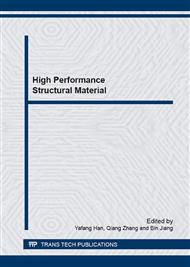[1]
Z.Z. Fang, X. Wang, T. Ryu, K.S. Hwang, H.Y. Sohn, Synthesis, sintering and mechanical properities of nanocrystailline cemented tungste carbide-A review, International Journal of Refractory Metals and Hard Materials. 27(2009) 288-299.
DOI: 10.1016/j.ijrmhm.2008.07.011
Google Scholar
[2]
B.R. Sunil, D. Sivaprahasam, R. Subasri, Microwave sintering of nanocrystalline WC–12Co: Challenges and perspectives, International Journal of Refractory Metals and Hard Materials, 28(2010) 180-186.
DOI: 10.1016/j.ijrmhm.2009.08.005
Google Scholar
[3]
X. Song, Y. Gao, X. Liu, C. Wei, H. Wang, W. Xu, Effect of interfacial characteristics on toughness of nanocrystalline cemented carbides, Acta Materialia, 61(2013) 2154-2162.
DOI: 10.1016/j.actamat.2012.12.036
Google Scholar
[4]
R. Bao, J. Yi, Densification and alloying of microwave sintering WC–8wt. %Co composites, International Journal of Refractory Metals and Hard Materials, 43(2014) 269-275.
DOI: 10.1016/j.ijrmhm.2013.12.010
Google Scholar
[5]
C.M. Fernandes, A. M. R. Senos, Cemented carbide phase diagrams: A review, International Journal of Refractory Metals and Hard Materials, 29(2011) 405-418.
DOI: 10.1016/j.ijrmhm.2011.02.004
Google Scholar
[6]
L. Gu, J. Huang, C. Xie, Effects of carbon content on microstructure and properties of WC–20Co cemented carbides, International Journal of Refractory Metals and Hard Materials, 42(2014) 228-232.
DOI: 10.1016/j.ijrmhm.2013.09.010
Google Scholar
[7]
R. Bao, J. Yi, Effect of sintering atmosphere on microwave prepared WC-8wt. %Co cemented carbide, International Journal of Refractory Metals and Hard Materials, 41(2013) 315-321.
DOI: 10.1016/j.ijrmhm.2013.05.003
Google Scholar
[8]
K.I. Rybakov, E. A. Olevsky, V. E. Semenov, The microwave ponderomotive effect on ceramic sintering, Scripta Materialia, 66(2012) 1049-1052.
DOI: 10.1016/j.scriptamat.2012.02.043
Google Scholar
[9]
R. Bao, J. Yi, H. Zhang, Y. Peng, A research on WC–8Co preparation by microwave sintering, International Journal of Refractory Metals and Hard Materials, 32(2012) 16-20.
DOI: 10.1016/j.ijrmhm.2012.01.001
Google Scholar
[10]
M. Oghbaei, O. Mirzaee, Microwave versus conventional sintering: A review of fundamentals, advantages and applications, Journal of Alloys and Compounds, 494(2010) 175-189.
DOI: 10.1016/j.jallcom.2010.01.068
Google Scholar
[11]
A. Mondal, D. Agrawal, A. Upadhyaya, Microwave sintering of refractory metalsalloysW Mo Re W-Cu W-Ni-Cu and W-Ni-Fe alloys, Journal of Microwave Power and Electromagnetic Energy, 44(2010) 28-44.
DOI: 10.1080/08327823.2010.11689768
Google Scholar
[12]
L. Sun, T. e. Yang, C. Jia, J. Xiong, VC, Cr3C2 doped ultrafine WC–Co cemented carbides prepared by spark plasma sintering, International Journal of Refractory Metals and Hard Materials, 29(2011) 147-152.
DOI: 10.1016/j.ijrmhm.2010.09.004
Google Scholar
[13]
L. Yiwen, S. Ronglu, W. Enxi, T. Ying, Effects of Codoped VC/Cr3C2 on Microstructure and Properities of Ultrafine Cenmented carbides, Rare Metal Materials and Engineering, 38(2009) 229-235.
Google Scholar
[14]
V. Bonache, M. D. Salvador, V. G. Rocha, A. Borrell, Microstructural control of ultrafine and nanocrystalline WC–12Co–VC/Cr3C2 mixture by spark plasma sintering, Ceramics International, 37(2011) 1139-1142.
DOI: 10.1016/j.ceramint.2010.11.026
Google Scholar
[15]
X.Q. Ou, M. Song, T.T. Shen, D.H. Xiao, Y.H. He, Fabrication and mechanical properties of ultrafine grained WC–10Co–0. 45Cr3C2–0. 25VC alloys, International Journal of Refractory Metals and Hard Materials, 29(2011) 260-267.
DOI: 10.1016/j.ijrmhm.2010.11.004
Google Scholar
[16]
G.S. Upadhyaya, Materials science of cemented carbides - an overview, Materials and Design, 22(2001) 483-489.
DOI: 10.1016/s0261-3069(01)00007-3
Google Scholar


